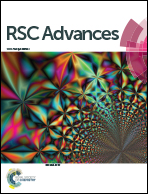Hydroconversion of carboxylic acids using mesoporous SBA-15 supported NiMo sulfide catalysts under microwaves
Abstract
Hydrogenation of octanoic acid was performed in a continuous manner, using microwaves (MW), and a supported metal sulfide catalyst. SBA-15, AlSBA-15 and ZrSBA-15 supported NiMo hydrotreating catalysts were prepared by an incipient wetness impregnation method in order to investigate the role of support acidity. Extrudates of the supported NiMo powders were prepared and sulfided. Octanoic acid in dodecane (10%) was introduced in the continuous flow reactor by means of an HPLC pump and co-fed with hydrogen at a working pressure of 0.5 MPa, while varying the reaction parameters such as temperature and feed flow rate (0.1, 0.25, and 0.5 mL min−1). The power applied to the monomodal cavity varied in the range of 15–150 W and corresponding temperature from 200–350 °C. Catalysts and supports were characterized by small- and wide-angle XRD, N2-physisorption (BET, BJH), HRTEM, ICP-MS, and NH3-TPD. The thermal response under MW showed that the extrudates containing SBA-15 (with or without Al or Zr) exhibited a strong MW response. The comparison of the catalytic activities showed that all SBA-15 supported NiMo catalysts exhibited the same activity range but the selectivity as compared to NiMo/Al2O3 catalysts was different.


 Please wait while we load your content...
Please wait while we load your content...